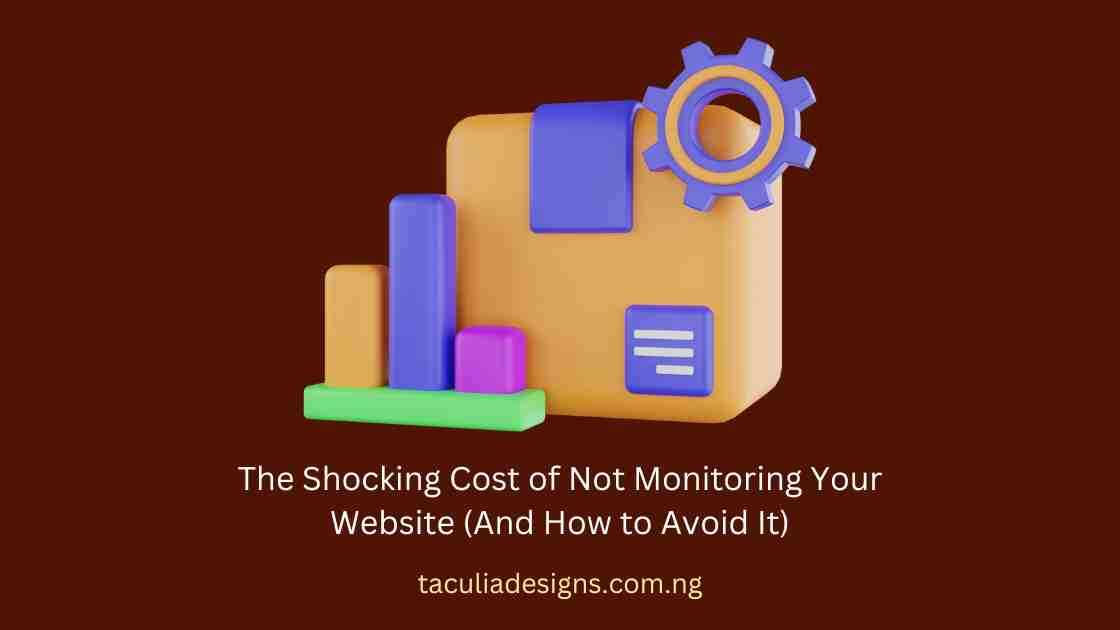Most business owners proudly invest in a beautiful website—modern design, clean layout, and fresh content. But what many forget is this: a website is not a “set it and forget it” asset.
Without monitoring, your site could be offline, broken, or even hacked—and you wouldn’t know until it’s too late.
And here’s the scary truth: the cost of not monitoring your website can be far higher than the cost of monitoring it.
Let’s break down the hidden dangers, the real financial risks, and how to avoid them.
The Hidden Costs of Ignoring Website Monitoring
The hidden cost of ignoring website monitoring are: losing revenue due to downtime, damaging your brand’s reputation, hurting your SEO, security breaches, hire recovery costs. Below are the explanations to each and everyone of this.
1. Lost Revenue from Downtime
Every minute your website is down, you’re losing potential customers. Studies show that even a few minutes of downtime can scare away users and send them straight to competitors.
Imagine running a campaign or ad, only for visitors to land on an error page because your site went down without you knowing. That’s wasted money and wasted opportunities.
2. Damaged Brand Reputation
Your website is often the first impression people get of your business. If they find it offline, slow, or riddled with errors, it screams “unreliable.”
Trust, once lost, is hard to win back. And bad experiences spread fast—especially if users complain on social media.
3. SEO Penalties
Search engines don’t like unreliable websites. Frequent downtime, slow speeds, and broken links can hurt your search rankings.
That means less visibility, fewer clicks, and less traffic. You could spend months writing content and building backlinks, only to see it wasted because of unmonitored technical issues.
4. Security Breaches
Hackers don’t always deface your site. Sometimes, they quietly inject malicious code, steal data, or redirect visitors elsewhere.
Without monitoring, you might not notice until Google blacklists your site, warning visitors it’s unsafe. Recovering from a hack is not just expensive—it’s reputation-crushing.
5. Higher Recovery Costs
Here’s the thing: fixing a hacked, broken, or downed site often costs more than preventing the problem.
Emergency developer fees
Lost revenue during downtime
Cleanup services for malware
Reputation repair campaigns
In short, prevention is always cheaper than cure.
How Much Does Downtime Really Cost?
Let’s put this into perspective with a simple formula:
Downtime Cost = (Average Traffic per Hour × Conversion Rate × Revenue per Conversion).
Example:
500 visitors per hour
2% conversion rate (10 customers)
$50 per sale
👉 One hour of downtime = $500 lost.
Now imagine your site is down for 4 hours overnight while you’re asleep. That’s $2,000 gone, and you didn’t even know it.
Real-World Example: Essieno Group
When we launched the Essieno Group website, monitoring revealed downtime that lasted about 15 minutes.
Had that downtime happened during peak business hours without monitoring, potential clients might have assumed the company was unprofessional—or worse, out of business.
Because we caught it quickly, the issue was fixed before it caused any real damage. Monitoring saved them both money and reputation.
Real-World Example: Taculia Entertainment
On Taculia Entertainment, monitoring flagged multiple broken links leading to 404 pages. Without monitoring, those errors would have quietly drained SEO authority and frustrated visitors.
By fixing them early, engagement improved, and organic traffic stayed strong.
This is a perfect example of how monitoring prevents small issues from becoming expensive problems.
Why Business Owners Skip Monitoring
From my experience at Taculia Designs, here are the common excuses:
- “I don’t have time.”
→ Monitoring is automated. It runs while you sleep. - “It’s too expensive.”
→ Basic monitoring tools are free. Advanced ones cost less than what you’d lose in 10 minutes of downtime. - “My hosting provider handles it.”
→ Hosting providers may monitor their servers, not your website’s content, speed, or broken links. - “My site looks fine.”
→ That’s what I thought until monitoring exposed silent downtime at odd hours.
How to Avoid the Costs of Not Monitoring
Step 1: Start with Free Tools
Use UptimeRobot or Pingdom Free to get downtime alerts.
Step 2: Add Performance Monitoring
Check page speeds with GTMetrix or Google PageSpeed Insights weekly.
Step 3: Set Up Security Alerts
Install plugins like Wordfence or Sucuri to catch suspicious logins and malware.
Step 4: Audit Regularly
Review broken links, images, and outdated content at least quarterly.
Step 5: Partner with Experts
If you don’t want to juggle tools, outsource monitoring to a team like Taculia Designs. We handle both monitoring and maintenance so you can focus on your business.
The Real Risk: Doing Nothing
Here’s the harsh truth:
If you’re not monitoring your website, it’s probably failing silently.
If you’re not catching failures, you’re probably losing money and trust every day.
By the time you notice, the damage may already be too big to fix easily.
Monitoring is not optional anymore. It’s the foundation of keeping your website—and your business—alive.
Final Thoughts
Not monitoring your website is like leaving your shop open overnight with no security cameras. Maybe nothing happens—or maybe you lose everything.
From downtime and lost revenue to hacks and SEO drops, the cost of ignoring monitoring is too high.
👉 The good news? Avoiding these disasters is simple: set up monitoring today.
At Taculia Designs, we don’t just build websites—we protect them. Monitoring is part of how we keep your site alive 24/7, so you never have to worry about silent failures draining your business.
So, ask yourself: Can you really afford not to monitor your website?
